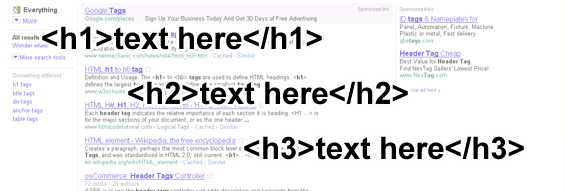
Your header tags can be great tools in aiding search engines in their quest to determine what your web site is about. I have seen many sites that completely ignore the placement, structure, content and use of these vital tags to their peril. Using these these tags correctly and effectively can help your on-site SEO efforts dramatically.
The header tags that carry the most weight are the h1, h2 and h3 tags. The h1 carries the most weight and influence with the search engines. As you might suspect the h2 tag comes in second and the h3 in last with as far as influencing the search engines. Using more than these three for on-site SEO is not an effective strategy because the weight the remaining header tags carry after the h3 tag is negligible.
The placement of these three header tags is important. The h1 should always be above the h2 and the h2 above the h3. With the h1 tag I have found success with placing it closer the the upper left hand corner. Search engines studies have determined that this is one of the first places the eye travel naturally. In my own experience I have seen the weight of the h1 tag coupled with the upper left placement drop listings for websites on the SERPS (Search Engine Results Pages) by more than a page!
The content of the tags bears a heavy influence on search results. First and foremost you want text not images for content. You also want that text to be short and concise. A standard rule of SEO is to optimize each page for not more 1-3 keywords and this should be reflected in the header tags.
Using your header tags correctly with SEO in mind you can ensure your site is getting the most from its on-site SEO. Together with other SEO best practices this technique can get you the SERPS listings and traffic your site needs to prosper.
Thank you for reminding me. It is one of the first you read when you study seo, I don’t know where on the line I started to forget it.
I didn’t know the sequence or order of the header tag is so important. Thank you for the tips, I will keep this in mind and make sure h1 always comes before h2. Cool stuff here.
I’ve had to always step back and reshuffle my header tags because more often than not, I have a stronger keyword in the rather than the primary . It’s good to see more posts like these!
Do you mean come first in the code or first on the page itself. For instance I may code the entire left side, and then the right but the h1 tag will be on the top right, so it will be ‘under’ some h2 tags in the code sequence, but above all of them in the page. I was also wondering about your thoughts for say 3 h1 tags. The usage for this would be the 3 main functions of a website with text under each.
It’s amazing how some simple content optimisation techniques such as the correct structuring of headers can help SEO!
I’m sorry, but i fail to see how the placement or order of H tags can indicate to a search engine that a page is more/less relevant than any other page with the same H tags but maybe out of order or in less prominent positions on the page.
This makes no sense, because it would force webmasters/designers to follow a rigid structure that not even the W3C DTD for HTML dictates. So if order of H tags is a signal for search engines, it must be extremely small. Oh and then there’s this Matt Cutts video http://www.youtube.com/watch?v=iR5itZlq8sk
WOW Simon, thanks for your sharing this knowledge and putting that Matt Cutts video explaining the order of H1 and H2 etc. I just started my second blog and I want to be very careful on my on-page SEO.
@ Simon. I would have to disagree with you. H1 tags are an important on-page element that Google uses besides (title tags, content, alt tags, etc.) to determine what your site is about.
Secondly, and while it is rigid, following a rigid structure makes it easier for your site to be accessible by the visually impaired who use screen readers to determine the content of your site.
Actually, here’s an article I wrote on it not too long ago:
http://www.pawelmartuszewski.co.uk/web_design_articles/google/semantic-html5-seo-friendliness/
Thanks,
Brian
The meta tags are a very important part of the HTML code of your web page. They are read by the search engines but are not displayed as a part of your web page design. Usually they include a concise summary of the web page content and you should include your relevant keywords in them. Most meta tags are included within the ‘header’ code of a website. The most important tags are the title, description, keyword s and robot tags.
Thank you for sharing your thoughts on the subject. I always like reading everyone’s opinions on the SEO. You can never stop learning. SEO is so vital to web page building and H1, H2, and H3 tags are just as important as any other part of the page. Thank you again for taking the time to share the information on how they should be placed and coded.
Thank you for the reminder. This seems to be very important to remember before I hit the publish button.
I have a little list of things I go through before I publish, but haven’t done this headline check before. Now I will…
Thank you…